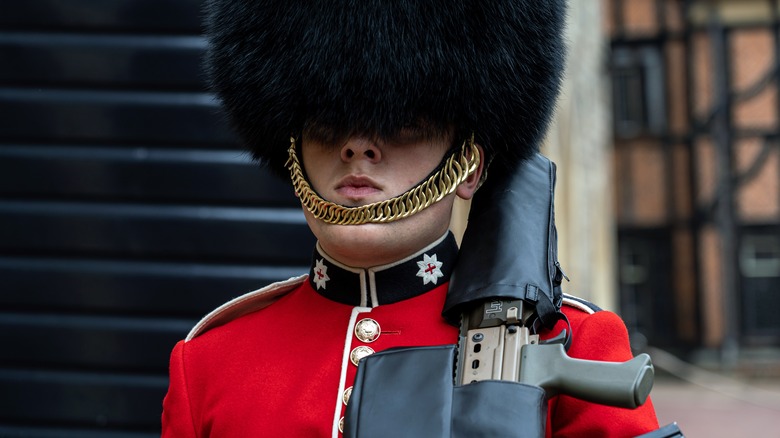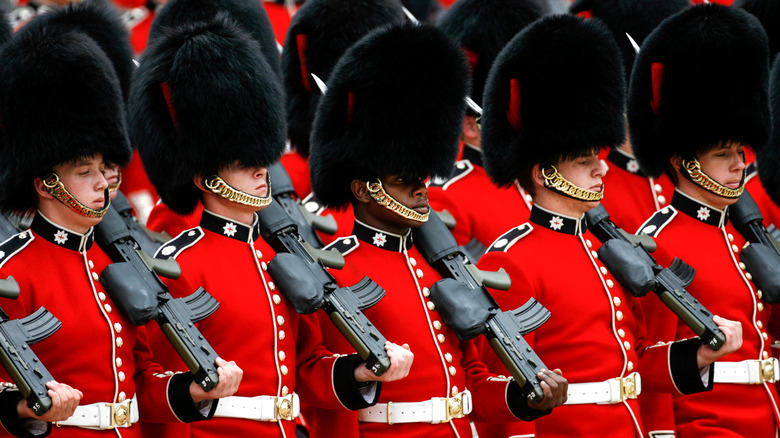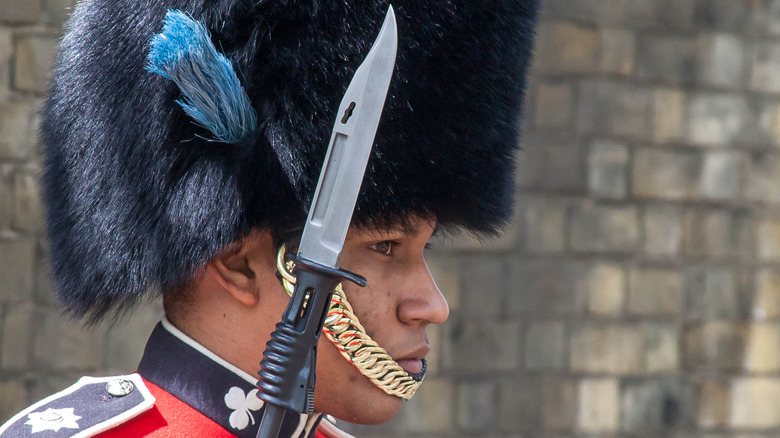What The Different Colored Plumes On The British Royal Guards' Hats Mean
They're one of the most enduring and beloved symbols of the United Kingdom — the Royal Guardsmen who protect the royal family, theatrically stiff and unsmiling in their scarlet tunics and tall, black bearskin hats. These soldiers of the Household Division of the British Armed Forces, according to their website, have served as the British monarch's personal bodyguard since the days of the English Civil War. To this day, the king or queen automatically holds the title of colonel-in-chief for each of the seven regiments. The men in bearskin appear in all their finery at ceremonies like the "Trooping the Colour" parade, held on the monarch's birthday; the opening of Parliament; and royal state visits.
The Royal Guardsmen are active soldiers, even the mounted Household Cavalry. (Horses play a bigger role in modern warfare than you might expect.) The armored infantry of the Scots Guard won distinction in the Falkland Islands in 1982; more recently, the Welsh Guards were "heavily involved" in Iraq and Afghanistan, per the Household Division's website. Not all bearskin caps are the same though — you may have noticed at least one difference.
The bearskin hat
But it's the ceremonial function of the Royal Guard that captures people's attention — or, to be more exact, the kit. The dashing red tunic is unmistakable, but the bearskin is the most dramatic, even exotic element. Yes, they are really made of bear skin. Londonist reports that the Household Division sources about 100 black bear pelts from Canada every year for them. It's the perfect material for the clammy British climate; perhaps it has a primitive, totemic value as well, as it did for the bear-shirted Viking berserkers a thousand years ago.
The Royal Guards' bearskins aren't quite that ancient, but they are a hoary old tradition. According to the National Interest, the bearskin first appeared in European armies in the 1700s. Initially, only heavy infantry, often called grenadiers, wore the distinctive hat. Grenadiers were big men — Napoleon's Grenadiers of the Guard had to be at least 5' 10", per the Fondation Napoléon – and the tall, shaggy hats made them look even bigger and more menacing.
In Britain, the height of the bearskin climbed throughout the 19th century. At the time of the Napoleonic Wars, a British bearskin was only a foot high. By 1831, the standard bearskin was 21 inches tall; at certain points, it reached 23 inches for officers, which was so heavy and awkward it actually got in the way of their riding. Eventually, the bearskin became too impractical for modern combat, but the Guards have worn them ceremonially ever since.
Each regiment has its plume
You may have noticed that some Royal Guards, but not all, have a colored plume tucked into the side of their bearskin. The Guardsman above has a blue one. What does the plume signify?
A Royal Guardsman explained to Insider that the plumes distinguish the seven regiments of the Guard from each other. A blue feather, like the one seen above, indicates an Irish Guardsman, known affectionately as the Micks and famous for their Irish wolfhound mascot (per the Household Division). The Coldstream Guards wear red plumes and the Grenadiers wear white. The Welsh Guards' plume is a sporty green and white, and the Scots Guards wear no plume at all.
The uniform has other, more arcane symbols as well. According to Insider, the arrangement of the gold buttons on the famous red shirts indicates regiment as well. A Coldstream Guardsman will have a line of buttons in groups of two, because the Coldstream Guards was the second regiment formed. The Irish Guards wear groups of four buttons, spaced apart, because they were the fourth.
The tasseled maroon sash has a more practical purpose. Originally, officers would tie a knot in the tassel for each casualty in combat, to have an accurate number for their post-battle report.


